Communication Skills Portfolio 4: COIT20249 Central Queensland Uni
VerifiedAdded on 2023/06/11
|5
|1209
|281
Portfolio
AI Summary
This portfolio demonstrates various communication skills through personal experiences and reflections. It includes an account of resolving a conflict through verbal communication and active listening, highlighting the importance of understanding different perspectives. The portfolio also discusses effective reading techniques for academic success and emphasizes the significance of teamwork and task delegation in project management. Furthermore, it explores the application of interpersonal skills in client interactions, the value of cultural sensitivity in a global university setting like Central Queensland University, and the use of communication technologies like emails for collaboration. The portfolio concludes with strategies for improving organizational responses to change and development by involving stakeholders and adopting new technologies. This assignment is available on Desklib, where students can find a wide array of solved assignments and past papers to aid in their studies.
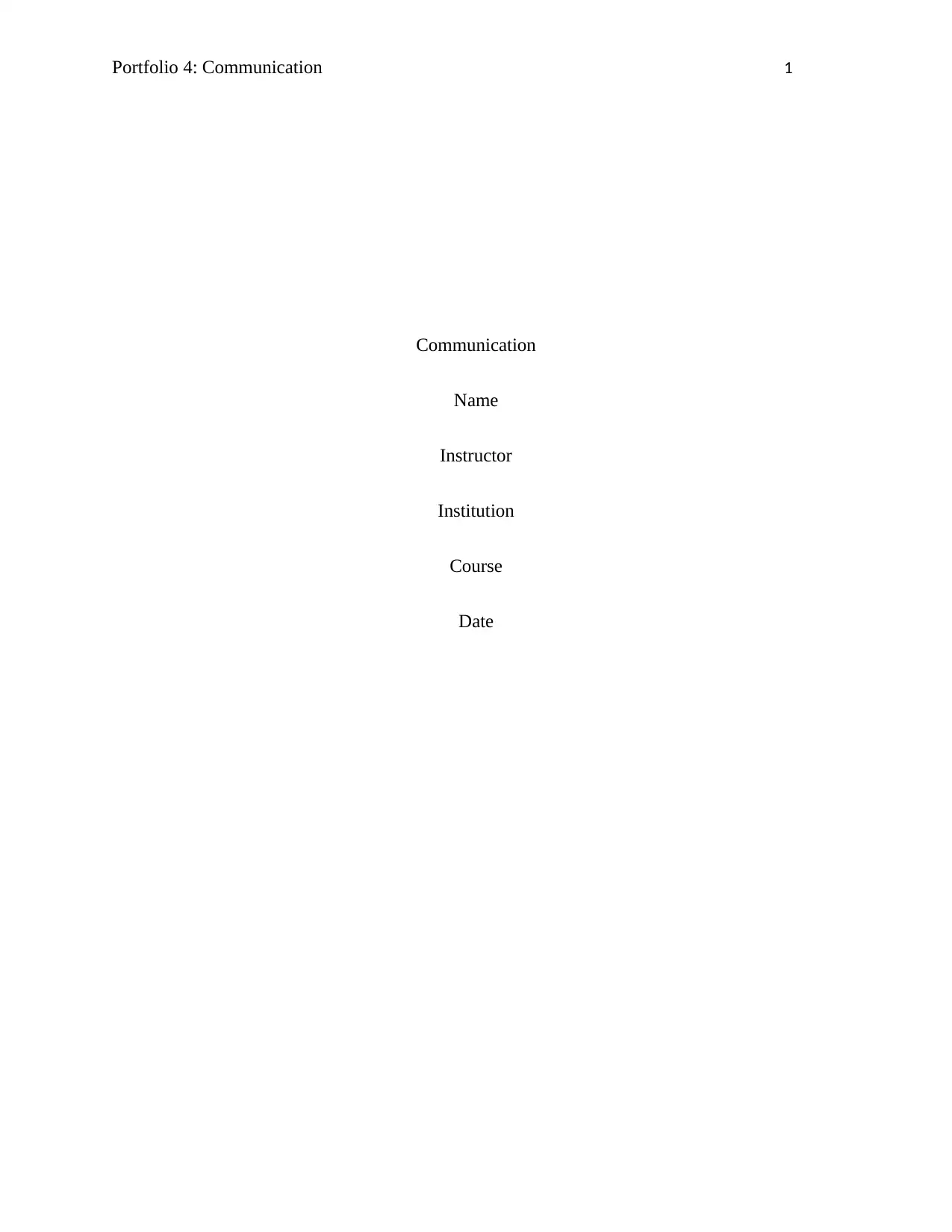
Portfolio 4: Communication 1
Communication
Name
Instructor
Institution
Course
Date
Communication
Name
Instructor
Institution
Course
Date
Paraphrase This Document
Need a fresh take? Get an instant paraphrase of this document with our AI Paraphraser
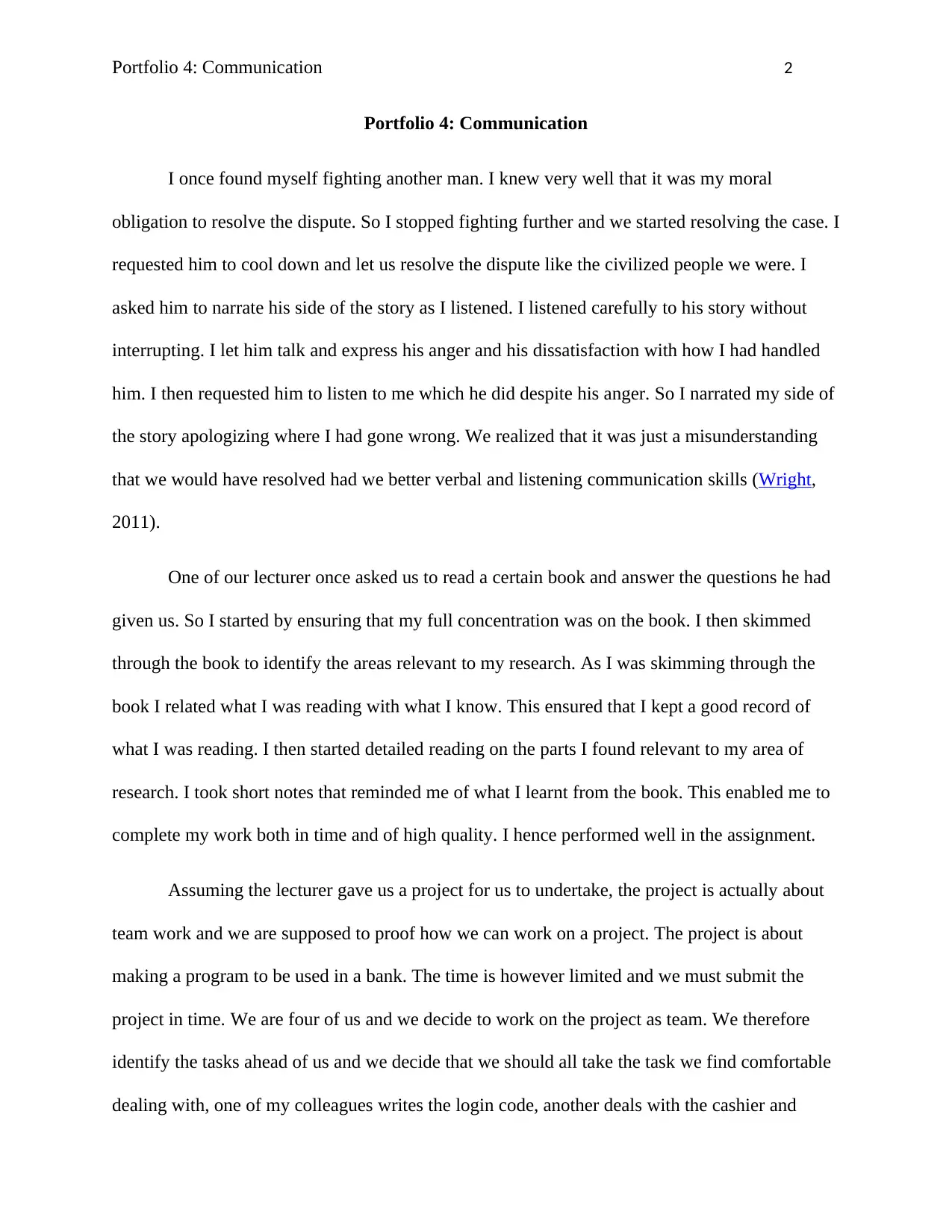
Portfolio 4: Communication 2
Portfolio 4: Communication
I once found myself fighting another man. I knew very well that it was my moral
obligation to resolve the dispute. So I stopped fighting further and we started resolving the case. I
requested him to cool down and let us resolve the dispute like the civilized people we were. I
asked him to narrate his side of the story as I listened. I listened carefully to his story without
interrupting. I let him talk and express his anger and his dissatisfaction with how I had handled
him. I then requested him to listen to me which he did despite his anger. So I narrated my side of
the story apologizing where I had gone wrong. We realized that it was just a misunderstanding
that we would have resolved had we better verbal and listening communication skills (Wright,
2011).
One of our lecturer once asked us to read a certain book and answer the questions he had
given us. So I started by ensuring that my full concentration was on the book. I then skimmed
through the book to identify the areas relevant to my research. As I was skimming through the
book I related what I was reading with what I know. This ensured that I kept a good record of
what I was reading. I then started detailed reading on the parts I found relevant to my area of
research. I took short notes that reminded me of what I learnt from the book. This enabled me to
complete my work both in time and of high quality. I hence performed well in the assignment.
Assuming the lecturer gave us a project for us to undertake, the project is actually about
team work and we are supposed to proof how we can work on a project. The project is about
making a program to be used in a bank. The time is however limited and we must submit the
project in time. We are four of us and we decide to work on the project as team. We therefore
identify the tasks ahead of us and we decide that we should all take the task we find comfortable
dealing with, one of my colleagues writes the login code, another deals with the cashier and
Portfolio 4: Communication
I once found myself fighting another man. I knew very well that it was my moral
obligation to resolve the dispute. So I stopped fighting further and we started resolving the case. I
requested him to cool down and let us resolve the dispute like the civilized people we were. I
asked him to narrate his side of the story as I listened. I listened carefully to his story without
interrupting. I let him talk and express his anger and his dissatisfaction with how I had handled
him. I then requested him to listen to me which he did despite his anger. So I narrated my side of
the story apologizing where I had gone wrong. We realized that it was just a misunderstanding
that we would have resolved had we better verbal and listening communication skills (Wright,
2011).
One of our lecturer once asked us to read a certain book and answer the questions he had
given us. So I started by ensuring that my full concentration was on the book. I then skimmed
through the book to identify the areas relevant to my research. As I was skimming through the
book I related what I was reading with what I know. This ensured that I kept a good record of
what I was reading. I then started detailed reading on the parts I found relevant to my area of
research. I took short notes that reminded me of what I learnt from the book. This enabled me to
complete my work both in time and of high quality. I hence performed well in the assignment.
Assuming the lecturer gave us a project for us to undertake, the project is actually about
team work and we are supposed to proof how we can work on a project. The project is about
making a program to be used in a bank. The time is however limited and we must submit the
project in time. We are four of us and we decide to work on the project as team. We therefore
identify the tasks ahead of us and we decide that we should all take the task we find comfortable
dealing with, one of my colleagues writes the login code, another deals with the cashier and
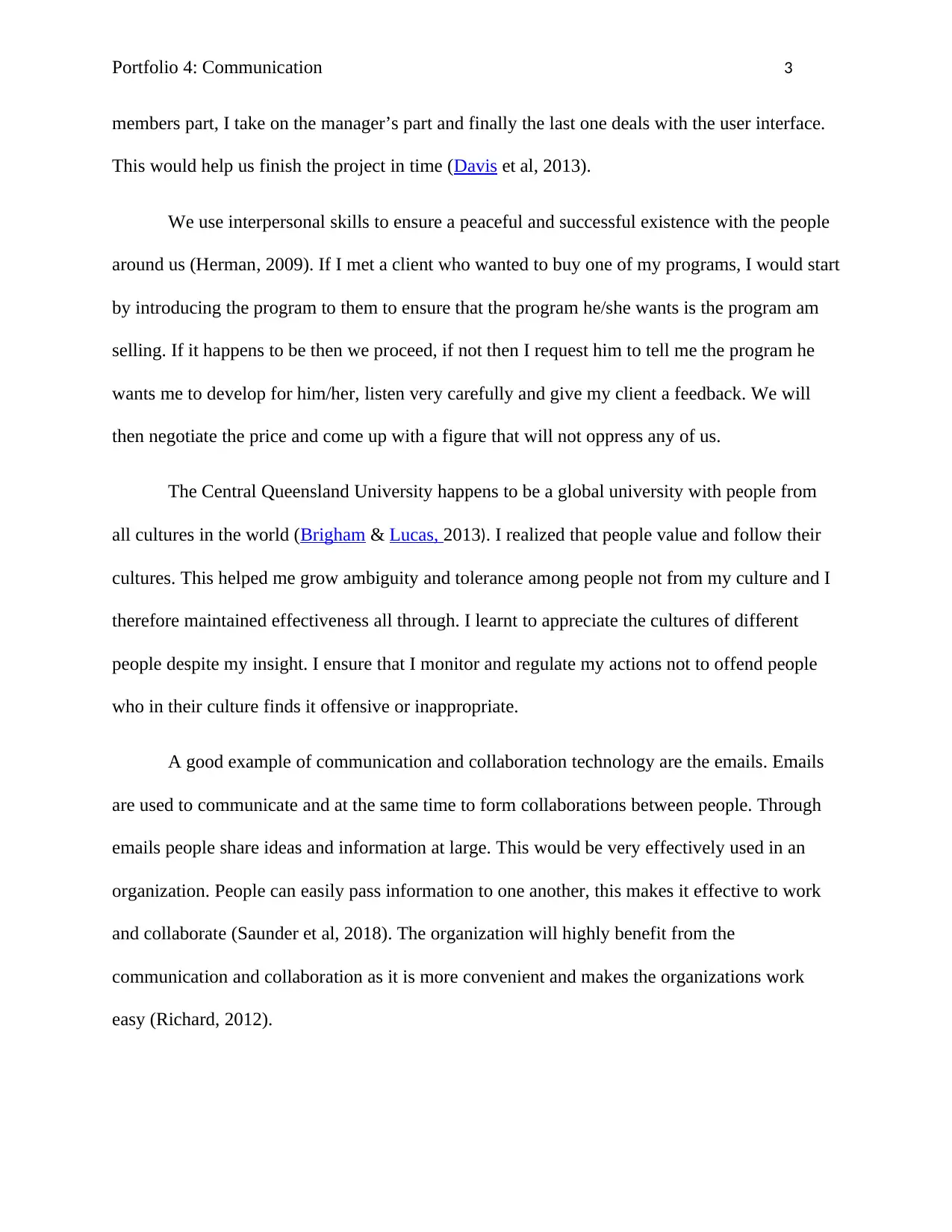
Portfolio 4: Communication 3
members part, I take on the manager’s part and finally the last one deals with the user interface.
This would help us finish the project in time (Davis et al, 2013).
We use interpersonal skills to ensure a peaceful and successful existence with the people
around us (Herman, 2009). If I met a client who wanted to buy one of my programs, I would start
by introducing the program to them to ensure that the program he/she wants is the program am
selling. If it happens to be then we proceed, if not then I request him to tell me the program he
wants me to develop for him/her, listen very carefully and give my client a feedback. We will
then negotiate the price and come up with a figure that will not oppress any of us.
The Central Queensland University happens to be a global university with people from
all cultures in the world (Brigham & Lucas, 2013). I realized that people value and follow their
cultures. This helped me grow ambiguity and tolerance among people not from my culture and I
therefore maintained effectiveness all through. I learnt to appreciate the cultures of different
people despite my insight. I ensure that I monitor and regulate my actions not to offend people
who in their culture finds it offensive or inappropriate.
A good example of communication and collaboration technology are the emails. Emails
are used to communicate and at the same time to form collaborations between people. Through
emails people share ideas and information at large. This would be very effectively used in an
organization. People can easily pass information to one another, this makes it effective to work
and collaborate (Saunder et al, 2018). The organization will highly benefit from the
communication and collaboration as it is more convenient and makes the organizations work
easy (Richard, 2012).
members part, I take on the manager’s part and finally the last one deals with the user interface.
This would help us finish the project in time (Davis et al, 2013).
We use interpersonal skills to ensure a peaceful and successful existence with the people
around us (Herman, 2009). If I met a client who wanted to buy one of my programs, I would start
by introducing the program to them to ensure that the program he/she wants is the program am
selling. If it happens to be then we proceed, if not then I request him to tell me the program he
wants me to develop for him/her, listen very carefully and give my client a feedback. We will
then negotiate the price and come up with a figure that will not oppress any of us.
The Central Queensland University happens to be a global university with people from
all cultures in the world (Brigham & Lucas, 2013). I realized that people value and follow their
cultures. This helped me grow ambiguity and tolerance among people not from my culture and I
therefore maintained effectiveness all through. I learnt to appreciate the cultures of different
people despite my insight. I ensure that I monitor and regulate my actions not to offend people
who in their culture finds it offensive or inappropriate.
A good example of communication and collaboration technology are the emails. Emails
are used to communicate and at the same time to form collaborations between people. Through
emails people share ideas and information at large. This would be very effectively used in an
organization. People can easily pass information to one another, this makes it effective to work
and collaborate (Saunder et al, 2018). The organization will highly benefit from the
communication and collaboration as it is more convenient and makes the organizations work
easy (Richard, 2012).
⊘ This is a preview!⊘
Do you want full access?
Subscribe today to unlock all pages.

Trusted by 1+ million students worldwide
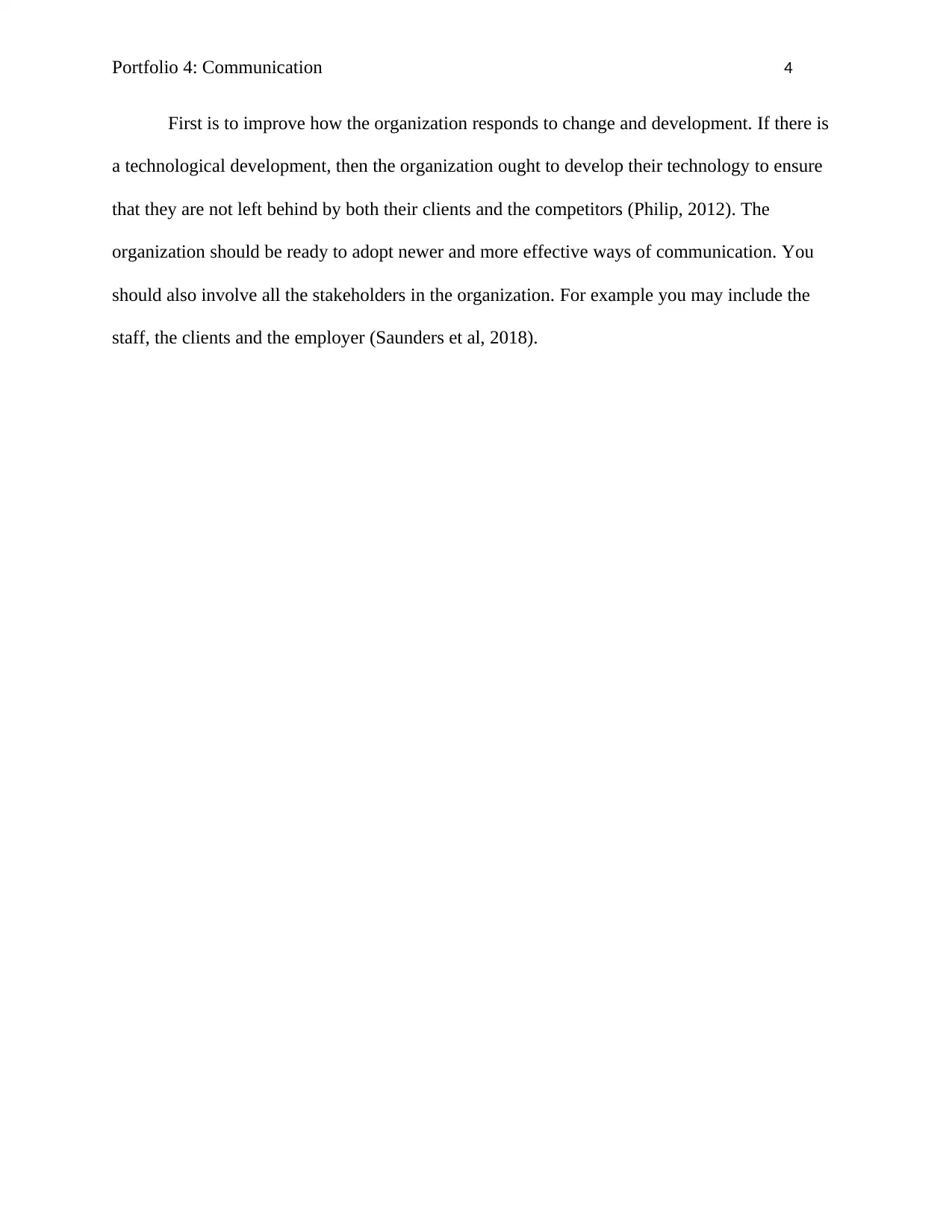
Portfolio 4: Communication 4
First is to improve how the organization responds to change and development. If there is
a technological development, then the organization ought to develop their technology to ensure
that they are not left behind by both their clients and the competitors (Philip, 2012). The
organization should be ready to adopt newer and more effective ways of communication. You
should also involve all the stakeholders in the organization. For example you may include the
staff, the clients and the employer (Saunders et al, 2018).
First is to improve how the organization responds to change and development. If there is
a technological development, then the organization ought to develop their technology to ensure
that they are not left behind by both their clients and the competitors (Philip, 2012). The
organization should be ready to adopt newer and more effective ways of communication. You
should also involve all the stakeholders in the organization. For example you may include the
staff, the clients and the employer (Saunders et al, 2018).
Paraphrase This Document
Need a fresh take? Get an instant paraphrase of this document with our AI Paraphraser
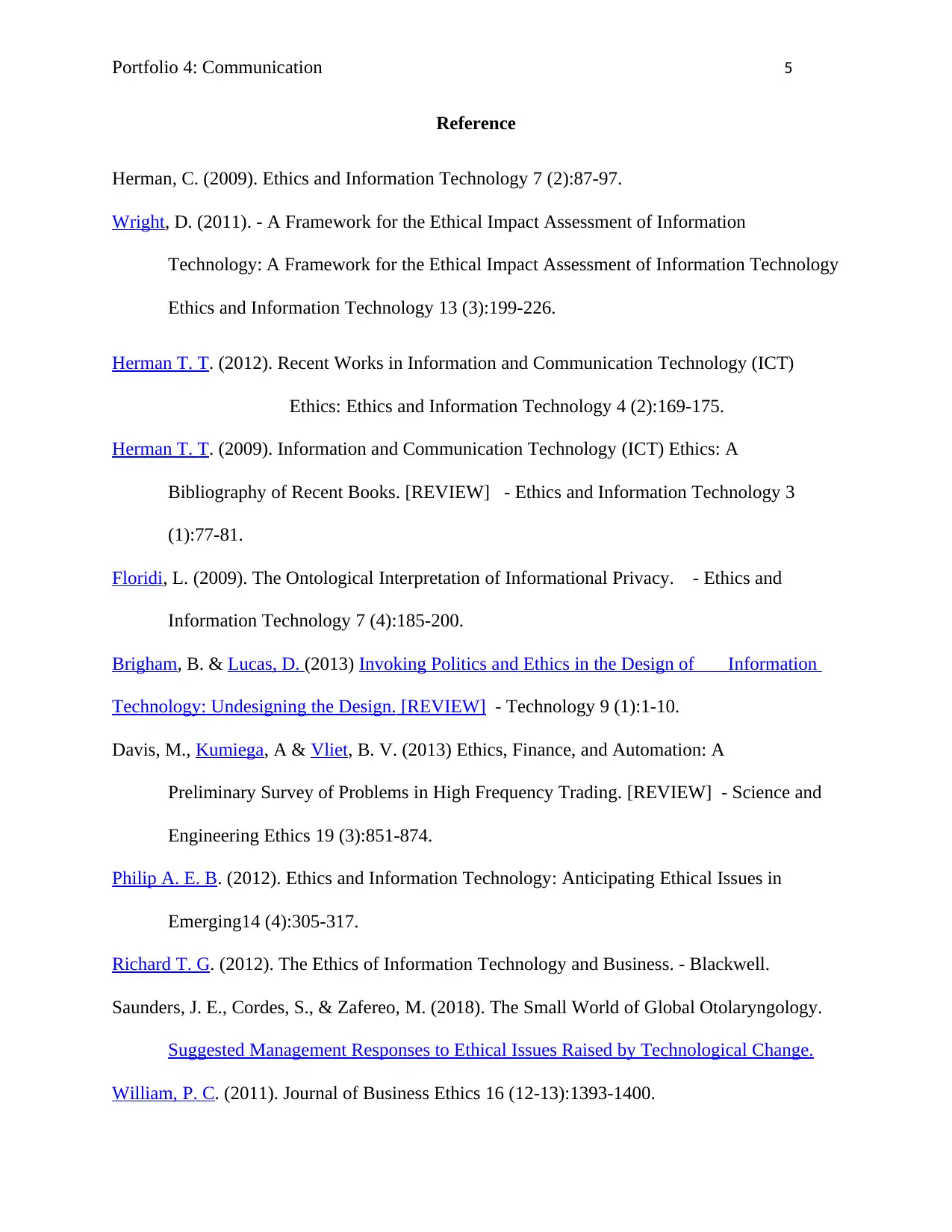
Portfolio 4: Communication 5
Reference
Herman, C. (2009). Ethics and Information Technology 7 (2):87-97.
Wright, D. (2011). - A Framework for the Ethical Impact Assessment of Information
Technology: A Framework for the Ethical Impact Assessment of Information Technology
Ethics and Information Technology 13 (3):199-226.
Herman T. T. (2012). Recent Works in Information and Communication Technology (ICT)
Ethics: Ethics and Information Technology 4 (2):169-175.
Herman T. T. (2009). Information and Communication Technology (ICT) Ethics: A
Bibliography of Recent Books. [REVIEW] - Ethics and Information Technology 3
(1):77-81.
Floridi, L. (2009). The Ontological Interpretation of Informational Privacy. - Ethics and
Information Technology 7 (4):185-200.
Brigham, B. & Lucas, D. (2013) Invoking Politics and Ethics in the Design of Information
Technology: Undesigning the Design. [REVIEW] - Technology 9 (1):1-10.
Davis, M., Kumiega, A & Vliet, B. V. (2013) Ethics, Finance, and Automation: A
Preliminary Survey of Problems in High Frequency Trading. [REVIEW] - Science and
Engineering Ethics 19 (3):851-874.
Philip A. E. B. (2012). Ethics and Information Technology: Anticipating Ethical Issues in
Emerging14 (4):305-317.
Richard T. G. (2012). The Ethics of Information Technology and Business. - Blackwell.
Saunders, J. E., Cordes, S., & Zafereo, M. (2018). The Small World of Global Otolaryngology.
Suggested Management Responses to Ethical Issues Raised by Technological Change.
William, P. C. (2011). Journal of Business Ethics 16 (12-13):1393-1400.
Reference
Herman, C. (2009). Ethics and Information Technology 7 (2):87-97.
Wright, D. (2011). - A Framework for the Ethical Impact Assessment of Information
Technology: A Framework for the Ethical Impact Assessment of Information Technology
Ethics and Information Technology 13 (3):199-226.
Herman T. T. (2012). Recent Works in Information and Communication Technology (ICT)
Ethics: Ethics and Information Technology 4 (2):169-175.
Herman T. T. (2009). Information and Communication Technology (ICT) Ethics: A
Bibliography of Recent Books. [REVIEW] - Ethics and Information Technology 3
(1):77-81.
Floridi, L. (2009). The Ontological Interpretation of Informational Privacy. - Ethics and
Information Technology 7 (4):185-200.
Brigham, B. & Lucas, D. (2013) Invoking Politics and Ethics in the Design of Information
Technology: Undesigning the Design. [REVIEW] - Technology 9 (1):1-10.
Davis, M., Kumiega, A & Vliet, B. V. (2013) Ethics, Finance, and Automation: A
Preliminary Survey of Problems in High Frequency Trading. [REVIEW] - Science and
Engineering Ethics 19 (3):851-874.
Philip A. E. B. (2012). Ethics and Information Technology: Anticipating Ethical Issues in
Emerging14 (4):305-317.
Richard T. G. (2012). The Ethics of Information Technology and Business. - Blackwell.
Saunders, J. E., Cordes, S., & Zafereo, M. (2018). The Small World of Global Otolaryngology.
Suggested Management Responses to Ethical Issues Raised by Technological Change.
William, P. C. (2011). Journal of Business Ethics 16 (12-13):1393-1400.
1 out of 5
Related Documents
Your All-in-One AI-Powered Toolkit for Academic Success.
+13062052269
info@desklib.com
Available 24*7 on WhatsApp / Email
![[object Object]](/_next/static/media/star-bottom.7253800d.svg)
Unlock your academic potential
Copyright © 2020–2025 A2Z Services. All Rights Reserved. Developed and managed by ZUCOL.




